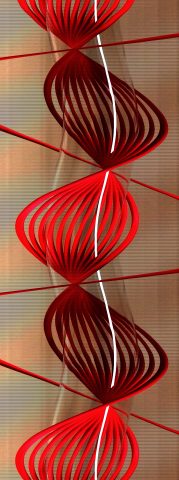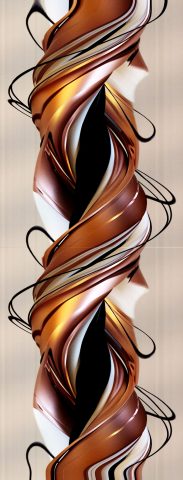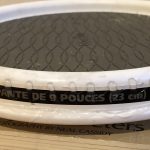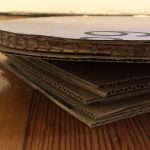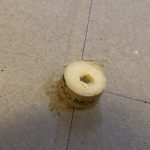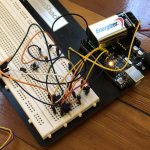DNA Design
For my final project, I aimed to experiment in slit-scanning. At first I was planning to use it to make a portrait series of my friend Julie and her extravagant clothes, but since the virus stopped us from seeing each other, I decided to make a self portrait series instead. As I experimented with my rotation mechanism (see details below), I realized my images resemble the helical shape of DNA. Combining the two ideas, if I had the ability to design my DNA, these images depict what I would want the sequences of my most important traits to look like.
RESOURCEFULNESS, DRIVE
This is a roll of Scotch tape, and this image is the epitome of this project — it illustrates my ability to accomplish my goal for this project despite the awful situation we’re in. As I have explained below, I created an entirely automatic rotation machine out of Arduino materials I happened to have in my closet, cardboard from all the boxes of groceries we’ve ordered, a Lazy Susan from my spice cabinet, corks from wine bottles, Scotch tape and a lot else, in order to pursue my visions for this project. I’ve always been this way: whenever there’s a problem, I set out to fix it in any way.
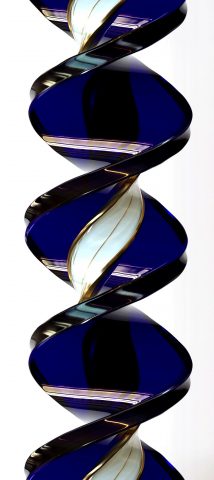 CURIOSITY, SPIRITUALITY
CURIOSITY, SPIRITUALITY
This is a glass clock. I grew up interested in a myriad of subjects, and one of my all time favorite fascinations is theoretical physics and the concept of dimensions and spacetime. I was recently writing a final paper for another class about the fourth dimension, and when she was in the room I asked my mom if she though time was another dimension. It led to an incredibly passionate conversation about our philosophies of life, religion, and spirituality, which I have only recently begun to understand for myself, and I connected with her an an entirely different level. The mixing of time and space is an idea that fascinates my entire family, and is becoming one of the main explorations in my art practice.
EMPATHY
These are cooking utensils, which represent, more literally, my family’s love for food, but also my devotion to love in general, which I learned from food. Every evening growing up, my family would sit down to a home-cooked dinner together, dropping our electronics, homework, or whatever else we were working on, and come together to eat and discuss our days and anything exciting (or depressing) that was going on in the world. Even if I didn’t know it until recently, this has been one of the most defining aspects of my life. Dinner is where I learned how to be polite and listen, make eloquent conversation, and understand and appreciate love. I am so grateful that this is how my family brought me up, and I plan to do the same with my own children someday.
CONFIDENCE
This is my wide-tooth hair comb, designed specifically for curly hair. Over the last few years, I’ve come to love my curly hair — and I used to really hate it. At the same time, my love for other aspects of myself, my abilities, and my decisions has also increased. I find that since coming to college and being even more independent than I was before it, I’m becoming more and more fearless. I know what I want, and I’m not afraid to ask for it. I think my hair was the key to my internal freedom.
MELOMANIAC
This one is a combination of music materials, including headphones, a guitar pick, and a mini amp. This aspect of me isn’t very deep — I just love music. I listen to and play it all the time. Plus it especially connects me to my dad.
Rotation Mechanism
Unfortunately, one of the bigger goals of this project, creating 3D models with photogrammetry, I was not able to achieve. I wanted to take slit-scans of the objects like I did above, but from multiple angles, to see if I could stitch them together in three dimensions. I’m not sure if my computer isn’t strong enough to see any depth (my computer crashed every 4 out of 5 tries) or this is just completely impossible to do, but after many many attempts, it never worked properly. However, two good things came out of my attempts. First, some cool GIFs of what the 3D models could potentially look like:


Second, what I predicted would be tricky about doing photogrammetry with these rotating images is that the rotation speed, starting position, and ending position all have to be constant or else the photos won’t look like they’re from the same “object” and the photogrammetry software won’t find any similar landmarks. I had to find a way to automate the process.
When I first started, I was looking for something in my house that spun smoothly. I found a little Lazy Susan in my spice cabinet and attached a string to the side, which I pulled to make it rotate. This was effective for a minute, but I quickly realized it’s impossible for a human to pull the string with a constant force, so the coils in my images would never be perfect without a machine. I needed to motorize the Lazy Susan.
Luckily, I had a bunch of Arduino pieces and cardboard lying around, so I sought out to do just that. It look a while; there was a lot of trial and error. Here’s a bit of documentation from the process.
Details

And it was successful! All the five images in the DNA series were made with my machine instead of by hand, making my image-making process super easy. I could focus a lot more on the composition of my rotating sculptures instead of futzing with the Lazy Susan. And if my laptop ever works, it would definitely be an effective device to do slit-scanning photogrammetry.


